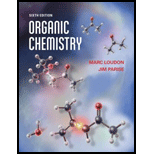
(a)
Interpretation:
The product of reaction of
Concept introduction:
The
Answer to Problem 18.47AP
The products formed on reaction of

Explanation of Solution
The reaction of

Figure 1
This reaction is known as electrophilic substitution reaction. The ortho, para directing power of hydroxyl group is greater than the methyl group, therefore, the sulfonic group is directed according to the position of hydroxyl group. Due to the presence of

Figure 2
The products formed on reaction of
(b)
Interpretation:
The product on reaction of
Concept introduction:
The chemical reaction in which an electrophile group is replaced by another functional group is known as electrophilic substitution reaction. When the electrophilic substitution happens on an aromatic ring such as benzene then the reaction is known as electrophilic aromatic substitution.
Answer to Problem 18.47AP
The products formed on reaction of

Explanation of Solution
The reaction of

Figure 3
Under dark conditions, there is electrophilic substitution reaction. In this reaction, bromine will get substituted at the benzene ring. The position of the bromine depends on the hydroxyl group as it has more ortho, para directing power than methyl group. Therefore, the products formed on reaction of

Figure 4
The products formed on reaction of
(c)
Interpretation:
The product on reaction of
Concept introduction:
The chemical reaction in which an electrophile group is replaced by another functional group is known as electrophilic substitution reaction. When the electrophilic substitution happens on an aromatic ring such as benzene then the reaction is known as electrophilic aromatic substitution.
Answer to Problem 18.47AP
The product on reaction of

Explanation of Solution
The reaction of

Figure 5
Under light conditions, there will be bromine radical formed and benzylic substitution will take place. Further, due to excess of bromine, bromine will get substituted at the benzene ring. The position of the bromine depends on the hydroxyl group as it has more ortho, para directing power than methyl group. Therefore, the products formed on reaction of

Figure 6
The product on reaction of
(d)
Interpretation:
The product on reaction of
Concept introduction:
The chemical reaction in which an electrophile group is replaced by another functional group is known as electrophilic substitution reaction. When the electrophilic substitution happens on an aromatic ring such as benzene then the reaction is known as electrophilic aromatic substitution.
Answer to Problem 18.47AP
No product is formed on reaction of
Explanation of Solution
The electron pair of oxygen of hydroxyl group is in conjugation with the phenyl ring. Due to this conjugation, it does not get protonated. Therefore, no reaction is taking place on adding dilute
There is no product formed on reaction of
(e)
Interpretation:
The product on reaction of
Concept introduction:
The chemical reaction in which an electrophile group is replaced by another functional group is known as electrophilic substitution reaction. When the electrophilic substitution happens on an aromatic ring such as benzene then the reaction is known as electrophilic aromatic substitution.
Answer to Problem 18.47AP
The product on reaction of
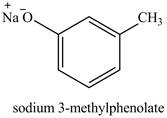
Explanation of Solution
The reaction of

Figure 7
On adding sodium hydroxide, the hydroxyl group gets deprotonated to form a phenolate ion. Therefore, the product formed on reaction of
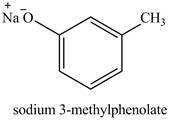
Figure 8
The product on reaction of
(f)
Interpretation:
The product on reaction of
Concept introduction:
The chemical reaction in which an electrophile group is replaced by another functional group is known as electrophilic substitution reaction. When the electrophilic substitution happens on an aromatic ring such as benzene then the reaction is known as electrophilic aromatic substitution.
Answer to Problem 18.47AP
The product on reaction of

Explanation of Solution
The reaction of

Figure 9
In this reaction, electrophilic substitution reaction occurs. Nitro will get substituted at the benzene ring. The position of the nitro group depends on the hydroxyl group as it has more ortho, para directing power than methyl group. Therefore, the products formed on reaction of

Figure 10
The product on reaction of
(g)
Interpretation:
The product on reaction of
Concept introduction:
The Friedel-Craft acylation is a type of electrophilic substitution reaction.
Answer to Problem 18.47AP
The products on reaction of

Explanation of Solution
The reaction of

Figure 11
The above reaction is an example of Friedel Crafts Acylation reaction. In the above reaction,

Figure 12
The products on reaction of
(h)
Interpretation:
The product formed on reaction of
Concept introduction:
Loss of electrons is classified as an oxidation reaction.
Answer to Problem 18.47AP
The product formed on reaction of

Explanation of Solution
The reaction of

Figure 13
The above reaction is an oxidation reaction. The phenol group that has no substitution at para group gets oxidized to

Figure 14
The product formed on reaction of
(i)
Interpretation:
The product on reaction of
Concept introduction:
Stille reaction is an example of coupling reaction. In Stille reaction, the triflate reacts with trimethylstannane in presence of
Answer to Problem 18.47AP
The product formed on reaction of
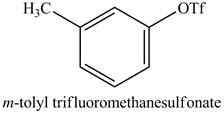
Explanation of Solution
The reaction of

Figure 15
In the above reaction, the triflic anhydride combines with the hydroxyl group of cresol to form

Figure 16
The product on reaction of
(j)
Interpretation:
The product on reaction of product of part (i) with
Concept introduction:
Stille reaction is an example of coupling reaction. In Stille reaction, the triflate reacts with trimethylstannane in presence of
Answer to Problem 18.47AP
The product on reaction of product of part (i) with
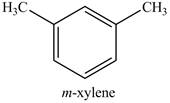
Explanation of Solution
The product of part (i) is shown below.
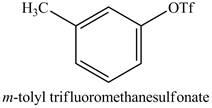
Figure 16
The reaction of product of part (i) with

Figure 17
In the above reaction,
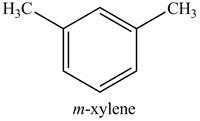
Figure 18
The product on reaction of product of part (i) with
(k)
Interpretation:
The product on reaction of product of part (i) with
Concept introduction:
The Suzuki coupling reaction is a reaction in which an aryl or vinylic boronic acid is coupled to an aryl or vinylic iodide or bromide. It is a
Answer to Problem 18.47AP
The product on reaction of product of part (i) with
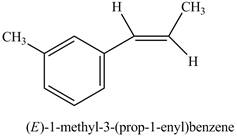
Explanation of Solution
The product of part (i) is shown below.
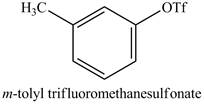
Figure 16
The reaction of product of part (i) with

Figure 19
The above reaction is Suzuki coupling reaction. In this reaction,
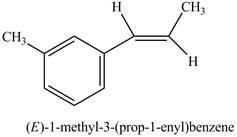
Figure 20
The product on reaction of product of part (i) with
Want to see more full solutions like this?
Chapter 18 Solutions
Organic Chemistry
- ● Biological Macromolecules Identifying the parts of a disaccharide Take a look at this molecule, and then answer the questions in the table below it. CH2OH O H H H OH OH OH H H CH2OH H O OH H OH H H H H OH Is this a reducing sugar? Does this molecule contain a glycosidic bond? If you said this molecule does contain a glycosidic bond, write the symbol describing it. If you said this molecule does contain a glycosidic bond, write the common names (including anomer and enantiomer labels) of the molecules that would be released if that bond were hydrolyzed. If there's more than one molecule, separate each name with a comma. Explanation Check O yes X O no ○ yes O no Uarrow_forwardThe aim of the lab is to measure the sodium content from tomato sauce using the Mohr titration method. There are two groups being: Regular Tomato sauce & Salt Reduced tomato sauce QUESTION: State how you would prepare both Regular & Salt reduced tomato sauce samples for chemical analysis using the Mohr titration methodarrow_forwardUsing the conditions of spontaneity to deduce the signs of AH and AS Use the observations about each chemical reaction in the table below to decide the sign (positive or negative) of the reaction enthalpy AH and reaction entropy AS. Note: if you have not been given enough information to decide a sign, select the "unknown" option. reaction observations conclusions A The reverse of this reaction is always spontaneous but proceeds faster at temperatures above -48. °C. ΔΗ is (pick one) ✓ AS is (pick one) B This reaction is spontaneous except below 114. °C but proceeds at a slower rate below 135. °C. ΔΗ is (pick one) AS is (pick one) ΔΗ is C This reaction is exothermic and proceeds faster at temperatures above -43. °C. (pick one) AS is (pick one) v Х 5 ? 18 Ararrow_forward
- ion. A student proposes the following Lewis structure for the perchlorate (CIO) io : :0: : Cl : - - : :0: ك Assign a formal charge to each atom in the student's Lewis structure. atom central O formal charge ☐ top O ☐ right O ☐ bottom O ☐ Cl ☐arrow_forwardDecide whether these proposed Lewis structures are reasonable. proposed Lewis structure Yes. Is the proposed Lewis structure reasonable? Cl- : 2: :Z: :Z: N—N : 0: C C1: O CO No, it has the wrong number of valence electrons. The correct number is: ☐ No, it has the right number of valence electrons but doesn't satisfy the octet rule. The symbols of the problem atoms are:* ☐ Yes. No, it has the wrong number of valence electrons. The correct number is: ☐ No, it has the right number of valence electrons but doesn't satisfy the octet rule. The symbols of the problem atoms are:* | Yes. No, it has the wrong number of valence electrons. The correct number is: No, it has the right number of valence electrons but doesn't satisfy the octet rule. The symbols of the problem atoms are:* | If two or more atoms of the same element don't satisfy the octet rule, just enter the chemical symbol as many times as necessary. For example, if two oxygen atoms don't satisfy the octet rule, enter "0,0". ☑arrow_forwardUse the observations about each chemical reaction in the table below to decide the sign (positive or negative) of the reaction enthalpy AH and reaction entropy AS. Note: if you have not been given enough information to decide a sign, select the "unknown" option. reaction observations conclusions ΔΗ is (pick one) A This reaction is faster above 103. °C than below. AS is (pick one) ΔΗ is (pick one) B This reaction is spontaneous only above -9. °C. AS is (pick one) ΔΗ is (pick one) C The reverse of this reaction is always spontaneous. AS is (pick one) 18 Ararrow_forward
- Use the observations about each chemical reaction in the table below to decide the sign (positive or negative) of the reaction enthalpy AH and reaction entropy AS. Note: if you have not been given enough information to decide a sign, select the "unknown" option. reaction observations conclusions A The reverse of this reaction is always spontaneous but proceeds slower at temperatures below 41. °C. ΔΗ is (pick one) AS is (pick one) ΔΗ is (pick one) B This reaction is spontaneous except above 94. °C. AS is (pick one) This reaction is always spontaneous, but ΔΗ is (pick one) C proceeds slower at temperatures below −14. °C. AS is (pick one) Х 00. 18 Ar 무ㅎ B 1 1arrow_forwardDraw the product of the reaction shown below. Ignore inorganic byproducts. + H CH3CH2OH HCI Drawingarrow_forwardplease explain this in simple termsarrow_forward
- K Most Reactive Na (3 pts) Can the metal activity series (shown on the right) or a standard reduction potential table explain why potassium metal can be prepared from the reaction of molten KCI and Na metal but sodium metal is not prepared from the reaction of molten NaCl and K metal? Show how (not). Ca Mg Al с Zn Fe Sn Pb H Cu Ag Au Least Reactivearrow_forward(2 pts) Why is O2 more stable as a diatomic molecule than S2?arrow_forwardDraw the Lewis structure for the polyatomic phosphite (PO¾³¯) a anion. Be sure to include all resonance structures that satisfy the octet rule. C I A [ ]¯arrow_forward
 ChemistryChemistryISBN:9781305957404Author:Steven S. Zumdahl, Susan A. Zumdahl, Donald J. DeCostePublisher:Cengage Learning
ChemistryChemistryISBN:9781305957404Author:Steven S. Zumdahl, Susan A. Zumdahl, Donald J. DeCostePublisher:Cengage Learning ChemistryChemistryISBN:9781259911156Author:Raymond Chang Dr., Jason Overby ProfessorPublisher:McGraw-Hill Education
ChemistryChemistryISBN:9781259911156Author:Raymond Chang Dr., Jason Overby ProfessorPublisher:McGraw-Hill Education Principles of Instrumental AnalysisChemistryISBN:9781305577213Author:Douglas A. Skoog, F. James Holler, Stanley R. CrouchPublisher:Cengage Learning
Principles of Instrumental AnalysisChemistryISBN:9781305577213Author:Douglas A. Skoog, F. James Holler, Stanley R. CrouchPublisher:Cengage Learning Organic ChemistryChemistryISBN:9780078021558Author:Janice Gorzynski Smith Dr.Publisher:McGraw-Hill Education
Organic ChemistryChemistryISBN:9780078021558Author:Janice Gorzynski Smith Dr.Publisher:McGraw-Hill Education Chemistry: Principles and ReactionsChemistryISBN:9781305079373Author:William L. Masterton, Cecile N. HurleyPublisher:Cengage Learning
Chemistry: Principles and ReactionsChemistryISBN:9781305079373Author:William L. Masterton, Cecile N. HurleyPublisher:Cengage Learning Elementary Principles of Chemical Processes, Bind...ChemistryISBN:9781118431221Author:Richard M. Felder, Ronald W. Rousseau, Lisa G. BullardPublisher:WILEY
Elementary Principles of Chemical Processes, Bind...ChemistryISBN:9781118431221Author:Richard M. Felder, Ronald W. Rousseau, Lisa G. BullardPublisher:WILEY





